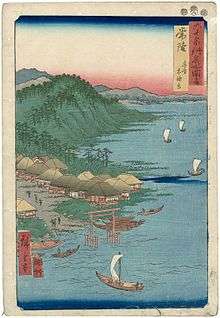Kashima Shrine
Kashima Shrine (鹿島神宮 Kashima Jingū) is a shrine dedicated to the Shinto Kami Takemikazuchi-no-Ōkami (武甕槌大神), one of the patron deities of martial arts. Various dojo (道場 Dōjō) of kenjutsu (剣術) and kendo (剣道 Kendō) sometimes display a Kakejiku (掛軸) hanging scroll emblazoned with Takemikazuchi-no-Ōkami. The shrine is located in Kashima, Ibaraki and is the home of Kashima Shintō-ryū (鹿島新当流). During the New Year period, from the first to the third of January, Kashima Shrine is visited by over 600,000 people from all over Japan. It is the second most visited shrine in Ibaraki prefecture (茨城県 Ibaraki-ken) for new year pilgrims.
| Kashima Shrine 鹿島神宮 (Kashima Jingu) | |
|---|---|
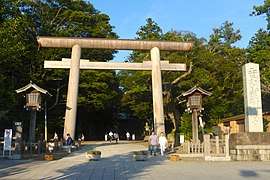 Main rebuilt torii gate, 2015 | |
| Religion | |
| Affiliation | Shinto |
| Deity | Takemikazuchi |
| Festival | Reitaisai (September 1) |
| Type | Shikinaisya Hitachi no Kuni ichinomiya Former kanpeitaisha Chokusaisha Beppyo jinja |
| Location | |
| Location | 2306-1, Kyuchu, Kashima, Ibaraki Prefecture, JAPAN, 314-0031 |
 Shown within Japan | |
| Geographic coordinates | 35°58′08″N 140°37′53″E |
| Architecture | |
| Style | Sangensya-Nagare-zukuri |
| Date established | (伝)初代神武天皇元年 |
| Website | |
| www | |
Tsukahara Bokuden (塚原 卜伝, 1489 - March 6, 1571), one of the most distinguished swordmasters in Japanese history, was a frequent visitor to the shrine and the son of one of its four retainers. The Kashima Shintō-ryū school of martial art was developed by him and is said to be derived from a combination of his own experiences as a shugyōsha during Musha shugyō (武者修行) and the Tenshin Shōden Katori Shintō-ryū (天真正伝香取神道流). Tsukuhara learned Katori Shintō-ryū from his adopted father at Katori Shrine (香取神宮 Katori Jingū) which has a strong connection to Kashima Shrine and dedicated to a similar patron deity.
Introduction
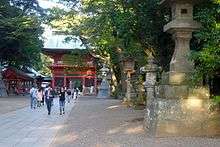

Kashima Shrine is located at the top of the Kashima plateau in south-east Ibaraki Prefecture (茨城県 Ibaraki-ken), intersecting Kitaura (北浦) and Kashimanada (鹿島灘). Before the Meiji restoration, together with Ise Grand Shrine (伊勢神宮 Ise Jingū) and Katori Shrine (香取神宮 Katori Jingū), all three were given status as Jingū (神宮). A shrine of high Imperial status.
The deities Takemikazuchi (武甕槌大神 Takemikazuchi-no-Ōkami) of Kashima Shrine and Futsunushi (経津主神 Futsunushi-no-kami) of Katori Shrine were considered great gods of the martial practices during the time of the Tenson kōrin (天孫降臨 Tenson Kōrin) (the descent of Amaterasu's (天照) grandson Ninigi (瓊瓊杵尊 Ninigi-no-Mikoto) from the heavens).
Due to the proximity of the Kashima and Katori Shrines to the Emishi or Ezo (蝦夷) people's territories, they became important frontline bases in the imperial court's war against the native people. This meant that both shrines saw a large flow of officials and military personnel through them. Even today on the first day of the new year emissaries and Shinto priests perform the Shihōhai (四方拝), the Imperial New Year's ceremony, as a display of respect for the services during the war.
Both shrines have maintained a strong connection to the martial arts for many years due to their kindred deities and many dojo throughout Japan display hanging scrolls with the two gods. A large blade designated as a National Treasure of Japan known as the Futsu-no-Mitama Sword (布都御魂剣) is housed in the treasure house of Kashima Shrine. The main shrine (本殿 Honden), prayer hall (拝殿 Haiden) and tower gate entrance (楼門 Rōmon) are also Important Cultural Property of Japan. The gate is one of the largest three shrine entrances in Japan. A deer enclosure is also located down the forest path. Both Kashima Shrine's deer and those of Nara are considered messengers of the gods and hence share a strong connection.
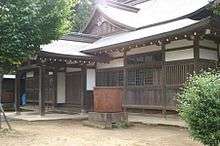
Enshrined deity
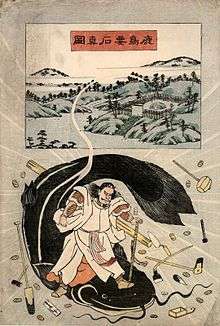
The upper section of this illustration shows the stone in Kashima Shrine while below the god Takemikazuchi is pinning the giant catfish Ōnamazu (大鯰) with his sword.
Ōnamazu (大鯰) is said to live below the islands of Japan and when aggravated is the cause of its many earthquakes. Takemikazuchi restrains the catfish through the use of the keystone.
Kashima Ōkami (鹿島大神 Kashima-no-Ōkami) is the official title of the main enshrined deity and named as Takemikazuchi (武甕槌大神). In historical texts he is also known as the great god of thunder.
According to legend the father of Japan, Izanagi (伊邪那岐 Izanagi), beheaded his own son Kagutsuchi (軻遇突智 Kagutsuchi) the fire deity, as punishment for burning his mother to death. As he performed the act the blood dripped from his sword splashing onto the rocks below him, giving birth to several gods. Two of which were Takemikazuchi along with Futsunushi (経津主神 Futsunushi-no-kami) the deity of Katori Shrine. Both are considered great deities of the military arts and have been sought by many swordsmen and those pursuing the martial arts throughout history.
History
According to records the shrine was established in the first year of Emperor Jimmu (神武天皇 Jimmu-tennō) in approximately 600BC. The ancient Fudoki (風土記) of Hitachi province (常陸国 Hitachi-no-Kuni) claims that in the time before heaven and earth, the great celestial god Kashima (香島の天の大神 Kashima-no-ten-no-Ōkami) descended from the heavens and throughout the reigns of Emperor Sujin (崇神天皇 Sujin-tennō), Emperor Yamato Takeru (日本武尊 Yamato Takeru-no-mikoto) and Emperor Tenji (天智天皇 Tenji-tennō) religious festivals and construction was carried out in the area of Kashima shrine in dedication and respect to the celestial god.
During the Heian period (平安時代 Heian-jidai) the Ise Grand Shrine (伊勢神宮 Ise Jingū), Kashima Shrine (鹿島神宮 Kashima Jingū) and Katori Shrine (香取神宮 Katori Jingū) were given imperial Shinto status under the ancient Engishiki doctrine (延喜式神名帳 Engi-Shiki Jinmyouchou). Since ancient times both Kashima shrine and Katori Shrine have been closely connected and served as important forward positions for the Yamato dynasty Imperial Court (大和朝廷 Yamato Chōtei) during their opposition of the Ezo and Emishi (蝦夷 Emishi, Ezo or Ebisu) peoples of northern Japan.
The treasure house of the shrine is said to hold the neck and its Japanese oke bucket container of Akurōu (悪路王), otherwise known as Aterui (アテルイ), which were presented for enshrinement by Fujiwara Mitsuru (藤原満 Fujiwara Mitsuru) of Mutsu province (陸奥国 Mutsu-no-kuni) in 1664, the fourth year of the Kanbun era (寛文 Kanbun).
2011 Tōhoku Earthquake
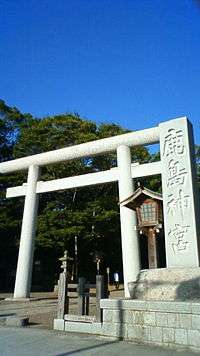
In the 2011 Tōhoku Disaster (東北地方太平洋沖地震 Tōhoku-chihō Taiheiyō Oki Jishin) on March 11, the large Shrine Torii (鳥居) gate was completely destroyed after it collapsed from the shock. Many of the shrine's large stone lanterns also fell over during the tremors and the water level of the pond at the back of the shrine also decreased. None of the treasures or Important Cultural Properties were damaged. In January 2012 construction of a new Torii (鳥居) gate began using Japanese Sugi (杉) Cedars from the grounds of the shrine. The work was scheduled to be completed in 2014.
Grand Imperial Ofuna Festival
This special festival held once every 12 years in the Year of the Horse is to honour the great deities Takemikazuchi (武甕槌大神 Takemikazuchi-no-Ōkami) of Kashima Shrine and Futsunushi (経津主神 Futsunushi-no-kami) of Katori Shrine. The festival is one of great pride for the people in the areas of Kashima and Katori and said to be one of the biggest in Japan. The next Grand Imperial Ofuna Festival will be in 2026.
The festival began during the time of Emperor Ōjin (応神天皇 Ōjin-tenno) although it was stopped once during the civil warring of the Muromachi period (室町時代 Muromachi-jidai). In 1870, the third year of the Meiji period (明治時代 Meiji-jidai), the tradition of the festival was revived and given grand imperial status. In 1887 it was decided that the festival would be held every 12 years in the Year of the Horse.
Today the Grand Imperial Ofuna festival begins in the morning on the first of September and officials from the imperial court are sent to convey the blessings of the Emperor. In the early morning of the second day a Mikoshi (神輿 or 御輿) from Kashima Shrine is carried overland along the edge of Lake Kitaura (北浦), a smaller part of Lake Kasumigaura (霞ヶ浦), to a large boat waiting in the harbor. The boat, adorned with a great Ryūtō (龍頭) dragon motif, then joins a larger fleet of other colourful boats (in 2002 there were around 90) and carries the Mikoshi across the lake to the other side. From there a divine procession awaits to take the Mikoshi to Katori Shrine (香取神宮 Katori Jingū) where the main festival takes place. After the festival a special temporary logging known as an Angu (行宮) is constructed and the Mikoshi is taken there before being returned to its main shrine in the afternoon of the third day.
Festivals and annual events
January
- New Years Day Service (1st, 06:00)
- Festival of Origins (3rd, 10:00)
- White Horse Festival (7th, 18:00)
February
- Setsubun Festival (Setsubun Day, 18:00)
- Kigen Era Festival (11th, 10:00)
- Bountiful Crops Festival (17th, 10:00)
March
- Saitousai Main Festival of Colour (9th, 10:00)
- Spring Festival (9th, 18:00)
- Spring Equinox and Spirits of the Ancestors Festival (Spring Equinox Day, 10:00)
April
- Rear Shrine Spring Service (1st, 10:00)
- Inner Shrine Spring Service (2nd)
- Shrine Ruins Spring Service (3rd)
- Sakado and Numao Shrine Spring Service (4th)
- Outer Shrine Spring Service (5th)
- Outer Shrine Divine Spring Service (6th)
- Ikisu Shrine Annual Spring Service (14th)
May
- Bountiful Harvest and Horseback Archery Festival (1st, 13:00)
June
- Summer Solstice Purification Ceremony (29th, 18:00)
- Ōharai Shinto Purification Ceremony (30th, 15:00)
September
- Grand Imperial Ofuna Festival (1st–3rd, in 2014)
- Annual Shrine Festival (1st, 10:00)
- Chinese Lantern Festival (1st, 18:00)
- Fortune Festival (1st, 20:00)
- Return of the Deities Festival (2nd, 15:00)
- Xinggong Angu Imperial Logging Festival (2nd, 22:00)
- Enshrinement of the Ancestors Festival (21st, 18:00)
- Autumn Equinox Festival (22nd, 08:00)
- Great Festival of Ancestral Spirits (22nd, 08:00)
October
- Offering of the Harvest Festival (17th, 10:00)
November
- Rear Shrine Autumn Service (1st, 10:00)
- Inner Shrine Autumn Service (2nd)
- Meiji Festival (3rd, 09:00)
- Sumo Festival (3rd, 10:00)
- Shrine Ruins Autumn Service (3rd)
- Sakado and Numao Shrine Autumn Service (4th)
- Outer Shrine Autumn Service (5th)
- Outer Shrine Autumn Service (6th)
- Ikisu Shrine Autumn Service (13th)
- Shinjyosai Offering of the Harvest to the gods (23rd, 10:00)
December
- Shrine Offerings Ceremony (20th, 10:00)
- Tencho Festival (23rd, 10:00)
- Shinto Purification Ceremony (31st, 15:00)
- New Year's Eve Service (31st, 15:00)
Monthly service
- Ceremony for the Ancestors (1st day of each month, 10:00)
See also
- List of National Treasures of Japan (crafts-swords)
- Kashima-Shinryu
- Kashima Shinden Jikishinkage-ryu
- Kashima Shinto-ryu
- Deer (mythology)
- List of Jingū
- Kashima Antlers
External links
| Wikimedia Commons has media related to Kashima-jingu. |
- Kashima Jingū website (in Japanese)
- Kashima City website (in English)
References
- Meik Skoss (1994). "A Bit of Background" Retrieved April 7, 2005.
- George Mccall (2009). "Tsukuhara Bokuden" Retrieved February 15, 2012.
